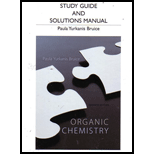
Concept explainers
a)
Interpretation:
- The rate determining step of the given reaction has to be predicted.
Concept Introduction:
Reactions of conjugated dienes:
An electrophilic addition reaction to a conjugated diene forms both
Kinetic and
Kinetic product: The more rapidly formed product is called the kinetic product. The reactions that produce the kinetic product as the major product are said to be kinetically controlled. The kinetic product predominates when the reaction is irreversible.
Thermodynamic product: The more stable product is called the thermodynamic product. The reactions that produce the thermodynamic product as the major product are said to be thermodynamically controlled. The thermodynamic product predominates when the reaction is reversible.
Rule: The stabilities of carbocation are,
b)
Interpretation:
- The product determining step of the given reaction has to be predicted.
Concept Introduction:
Reactions of conjugated dienes:
An electrophilic addition reaction to a conjugated diene forms both
Kinetic and thermodynamic products:
Kinetic product: The more rapidly formed product is called the kinetic product. The reactions that produce the kinetic product as the major product are said to be kinetically controlled. The kinetic product predominates when the reaction is irreversible.
Thermodynamic product: The more stable product is called the thermodynamic product. The reactions that produce the thermodynamic product as the major product are said to be thermodynamically controlled. The thermodynamic product predominates when the reaction is reversible.
Rule: The stabilities of carbocation are,
Want to see the full answer?
Check out a sample textbook solution
Chapter 8 Solutions
Organic Chemistry
- Why a conjugated diene is more stable than an isolated diene ?arrow_forward(1) Which is an isolated diene? (2) Which is an alkene with possible rearrangement product (1,2-H shift) with reaction to HI? (3) Whixh isa diene capable of having 1,2 and 1,4-addition products? (4) Which is a conjugated diene?arrow_forwardCircle the best dienophilearrow_forward
- Rank the following dienes in their rate of reaction with the same dienophile in a Diels-Alder reaction. For example, 1 = fastest or most reactive diene, 4 = slowest or least reactive diene.arrow_forwardRank the following dienophiles in their rate of reaction with the same diene in a Diels-Alder reaction. For example, 1 = fastest or most reactive dienophile, 4 = slowest or least reactive dienophile.arrow_forwardThe Br produced by the reaction in Figure 9.2 could combine with the carbocation you drew to give a dibromide product (a product with two Br atoms). Use a curved arrow to show the Br making a bond to the carbocation, and draw the resulting dibromide product.arrow_forward
- a) Which student’s reaction (Danny or Claire) has provided a single elimination isomer? b) Draw all the elimination isomers obtained from both students’ reactions. c) Which of the dienes drawn (by you) in question 3b is the most stable? Circle that diene above.arrow_forward1. Which among these would be the most stable carbocation?a. Allylicb. Vinylicc. Primaryd. Secondary2. What is the primary reason for the stability of tertiary carbocations?a. Free rotationb. Resonancec. Hyperconjugationarrow_forward1 example for organic rearrangement reaction show: a. the overall reaction (reactants --> products) b. the reaction mechanism (indicate intermediate product) c. indicate which is the reactive species or intermediate in the reaction (radical? electrophile? nucleophile?) d. overall description of the reaction eg., radical substitution or SRarrow_forward
- Draw the starting Diene and Dienophile.arrow_forward1 example of reaction for each of the types of organic reactions: substitution, elimination, addition, and rearrangement. Show:a. the overall reaction (reactants --> products)b. the reaction mechanism (indicate intermediate product)c. indicate which is the reactive species or intermediate in the reaction (radical? electrophile? nucleophile?)d. overall description of the reaction eg., radical substitution or SRarrow_forwardDraw the starting diene and dieneophilearrow_forward
 Organic Chemistry: A Guided InquiryChemistryISBN:9780618974122Author:Andrei StraumanisPublisher:Cengage Learning
Organic Chemistry: A Guided InquiryChemistryISBN:9780618974122Author:Andrei StraumanisPublisher:Cengage Learning

